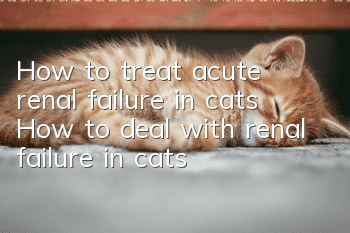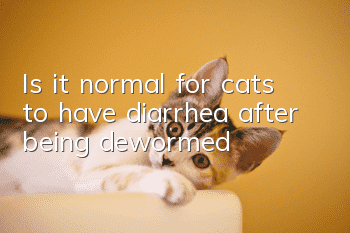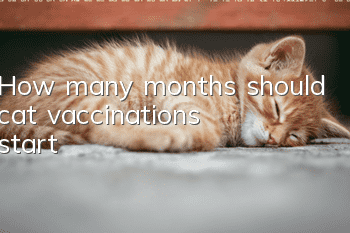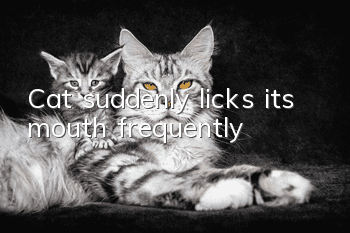How to treat acute renal failure in cats? How to deal with renal failure in cats!

Cats can also suffer from renal failure
How to treat acute renal failure in cats? What to do in response to renal failure in cats! Renal failure is divided into acute renal failure and chronic renal failure in terms of course and pathology. Compared with chronic renal failure, Renal failure is not easy to detect in the early stages. When symptoms occur, kidney function has declined significantly and requires immediate medical attention. Acute renal failure is characterized by a sudden stop of kidney function. Most of the symptoms are decreased urine or acute uremia, which is often better. Judgment and timely treatment can also be obtained. But renal failure is ultimately painful for cats, and we should pay attention to it in our daily feeding.
1. Pathogenesis
1. Nephrotoxin is the most common cause of ARF in small animals. Nephrotoxins that can cause ARF include endotoxins, drugs, anesthetics, radiocontrast agents, and endogenous pigments.
2. Renal ischemia is mainly due to low renal blood perfusion and severe dehydration, prolonged anesthesia, heart failure, hypovolemic shock, thromboembolism (such as disseminated intravascular coagulation) , vasculitis and transfusion reaction), malignant hypertension, heat stroke, excessive vasoconstriction (such as the use of non-steroidal anti-inflammatory drugs, NSAIDs), excessive vasodilation (such as the administration of angiotensinase inhibitor Aceh or antihypertensive drugs), etc.
3. Infectious sources that can cause ARF include leptospiraspp, Rocky Mountain spotted fever, Ehrlichia canis and any bacteria that can cause pyelonephritis. In short, acute pyelonephritis does not cause renal failure unless ureteral obstruction occurs. Occasionally, ARF may develop secondary to embolism in left-sided purulent endocarditis.
2. Clinical symptoms
1. Depression, depression, collapse
2. Anorexia, uremia
< p>3. Vomiting, diarrhea accompanied by melena4. Other organ dysfunction occurs: a. Jaundice b. Congestion and ecchymosis c. Tachypnea, tachycardia d. Low temperature or high fever e. The mucous membrane is brick red or earthy.
Acute renal failure has three different stages: (1) initial stage, (2) maintenance stage, and (3) recovery stage. Treatments that reduce kidney damage during the initial stages can prevent the progression of already existing acute renal failure. The maintenance phase is characterized by the development of tubular damage and nephron dysfunction. Although treatments at this stage are designed to save life, they often do little to slow the severity of kidney damage, improve kidney function, or promote recovery. During the recovery phase, kidney damage is repaired and kidney function improves. If the basement membrane in the renal tubules is intact and active epithelial cells are present, the damage to the renal tubules is reversible. Although new nephrons cannot be generated and irreversible nephron damage cannot be repaired, the remaining nephrons will become functionally hypertrophic enough to adequately compensate for the loss of nephrons.Function. Even if the function of the kidneys has not been fully restored, the functions of the kidneys can still be fully exerted.
3Diagnosis:
1. Possible history of potential nephrotoxicity or ischemia, based on clinical symptoms;
< p>2. Acute azotemia and hyperphosphatemia occur;3. Oliguria/anuria is common during ischemia, and ARF caused by Qingda and cisplatin is not oliguria. Sexual ARF.
4. Abdominal palpation, pain in the kidney area;
5. Renal tissue biopsy can be performed in the following situations: ① The diagnosis cannot be clearly confirmed, ② There is obvious persistent proteinuria, ③ Multiple tumors are suspected The effects of traditional treatment of sexual systemic diseases are not obvious: lasting for more than 1 to 2 days, low urine output or lasting for more than 4 to 5 days, severe uremia and hyperkalemia. ④ Carry out histological examination to determine the prognosis. Histological signs of tubular regeneration and intact tubular basement membranes indicate a good prognosis; extensive tubular necrosis and interstitial damage to the basement membrane mineralization indicate a poor prognosis.
IV. Treatment:
General treatment methods:
Purpose: Correct the hemodynamics of the kidneys Abnormalities in blood circulation and water-salt metabolism imbalances can be alleviated, giving the kidneys enough time to recover and compensate. The treatment response is as follows: first, the serum creatinine concentration decreases, indicating an increase in glomerular filtration; secondly, an increase in urine production (if oliguria or anuria was originally made)
Special therapy:
Liquid Therapy is the mainstay of treatment for ARF; correcting fluid and electrolyte balance, improving renal hemodynamics and inducing polyuria. Replenish intravenous fluids within the first 4-6 hours; when cardiovascular dysfunction is suspected, infuse slowly! You can use 0.45% NaCl and 2.5% dextran or 0.9% NaCl. If edema occurs, infusion should be slow and diuretics and/or vasodilators may be given. If oliguria persists after fluid therapy, one or more of the following methods can be used. Furosemide, mannitol, low dose dopamine. Furosemide is more effective when infused with mannitol and dopamine than alone. If urination still cannot be promoted within 4 to 6 hours, consider using dialysis therapy. Treat hyperkalemia. For severe hyperkalemia (>6~8mEq/L) (normal value: 3.0-3.5) or hyperkalemia leading to cardiovascular disease, the following drugs can be used: 5% NaHCO3, 10% calcium gluconate, to induce polyuria, excretion Potassium. Correct metabolic acidosis. Prevent infection. Antiemetic: famotidine or ranitidine or cimetidine.
- What are the characteristics of feline hemobartonellosis? How to treat it?
- How to treat wounds on cats?
- What foods should not be given to cats at will?
- Cat urinates frequently and only urinates a little each time
- Several things you must pay attention to when raising a cat
- Is it normal for cats to lose appetite in summer? Cat owners don’t need to panic!
- Is it necessary to vaccinate a cat that is 6 months old?
- Is Monstera deliciosa poisonous to cats?
- Is it normal for a cat not to urinate for two days after arriving at a new home?
- Should I stop the new cat from getting angry at the old cat?



